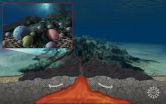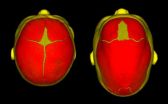(Press-News.org) PHILADELPHIA — Several fatal brain disorders, including Parkinson's disease, are connected by the misfolding of specific proteins into disordered clumps and stable, insoluble fibrils called amyloid. Amyloid fibrils are hard to break up due to their stable, ordered structure. For example, α-synuclein forms amyloid fibrils that accumulate in Lewy Bodies in Parkinson's disease. By contrast, protein clumps that accumulate in response to environmental stress, such as heat shock, possess a less stable, disordered architecture.
Hsp104, an enzyme from yeast, breaks up both amyloid fibrils and disordered clumps. In the most recent issue of Cell, James Shorter, PhD, assistant professor of Biochemistry and Biophysics, and colleagues from the Perelman School of Medicine, University of Pennsylvania, show that Hsp104 switches mechanism to break up amyloid versus disordered clumps. For stable amyloid-type structures, Hsp104 needs all six of its subunits, which together make a hexamer, to pull the clumps apart. By contrast, for the more amorphous, non-amyloid clumps, Hsp104 required only one of its six subunits.
Unexpectedly, the bacterial version of the Hsp104 enzyme, called ClpB, behaves differently compared to Hsp104. Bacterial ClpB uses all six subunits to break up amorphous clumps and fails to break up amyloid fibrils. Bacteria just ignore these more stable structures, whereas yeast use Hsp104 to exploit amyloid fibrils for beneficial purposes.
"One surprise is that biochemists thought that Hsp104 and ClpB hexamers worked in the same way," says first author and graduate student in the Shorter lab Morgan DeSantis. "This is not the case."
Hsp104 breaks up the protein clumps by "pulling" individual polypeptide chains through a channel that the hexamer forms at its center, recruiting more subunits to the job, as needed. Individual polypeptides emerge on the other side where they can be refolded into active structures. Remarkably, Hsp104 broke up various amyloid fibrils formed by proteins connected to Alzheimer's disease (tau and Ab42), Parkinson's disease (α-synuclein), Huntington's disease (polyglutamine), and even type II diabetes (amylin).
The bad news is that animals do not harbor their own version of Hsp104 and they do not appear to have the protein machinery to break up amyloid clumps as rapidly. But Shorter views this as a possible therapeutic opportunity: "We want to introduce Hsp104 transiently as a therapeutic clump buster and optimize Hsp104 for each type of disease protein." He is heartened by preclinical evidence that Hsp104 rescues neurodegeneration caused by α-synuclein misfolding in a rat model of Parkinson's disease. His lab is now scanning yeast cells to look for the most useful forms of Hsp104.
###
Co-authors are Eunice H. Leung, Elizabeth A. Sweeny, Meredith E. Jackrel, Mimi Cushman-Nick, Alexandra Neuhaus-Follini, Shilpa Vashist, Matthew A. Sochor, and M. Noelle Knight, all from Penn.
The research was funded by NIH training grants (T32GM071339; T32GM008275; T32AG000255); NRSA predoctoral fellowships (F31NS079009; F31NS067890); AHA predoctoral and postdoctoral fellowships; an NIH Director's New Innovator Award (DP2OD002177), an Ellison Medical Foundation New Scholar in Aging Award, and Penn Institute of Aging, Alzheimer Disease Core Center, and Diabetes Research Center Awards.
Penn Medicine is one of the world's leading academic medical centers, dedicated to the related missions of medical education, biomedical research, and excellence in patient care. Penn Medicine consists of the Raymond and Ruth Perelman School of Medicine at the University of Pennsylvania (founded in 1765 as the nation's first medical school) and the University of Pennsylvania Health System, which together form a $4.3 billion enterprise.
The Perelman School of Medicine is currently ranked #2 in U.S. News & World Report's survey of research-oriented medical schools. The School is consistently among the nation's top recipients of funding from the National Institutes of Health, with $479.3 million awarded in the 2011 fiscal year.
The University of Pennsylvania Health System's patient care facilities include: The Hospital of the University of Pennsylvania -- recognized as one of the nation's top "Honor Roll" hospitals by U.S. News & World Report; Penn Presbyterian Medical Center; and Pennsylvania Hospital — the nation's first hospital, founded in 1751. Penn Medicine also includes additional patient care facilities and services throughout the Philadelphia region.
Penn Medicine is committed to improving lives and health through a variety of community-based programs and activities. In fiscal year 2011, Penn Medicine provided $854 million to benefit our community.
Yeast protein breaks up amyloid fibrils and disease protein clumps differently
Heat Shock Protein Hsp104 could be developed to eliminate toxic clumps linked with neurodegenerative diseases
2012-11-20
ELSE PRESS RELEASES FROM THIS DATE:
New study review examines benefits of music therapy for surgery patients
2012-11-20
LEXINGTON, Ky. (Nov. 19, 2012) — A new study review published by the University of Kentucky found that music therapy can be beneficial to patients before, during and after a surgical procedure and may reduce pain and recovery time.
Published in the Southern Medical Journal, the review examined the use of music in the preoperative, intraoperative and postoperative stages of the surgical process, and music was shown to have positive results in all three stages. Patients were less anxious before the procedure and recovered more quickly and satisfactorily after by being exposed ...
'Dark Energy': Life beneath the seafloor discussed at upcoming American Geophysical Union conference
2012-11-20
"Who in his wildest dreams could have imagined that, beneath the crust of our Earth, there could exist a real ocean...a sea that has given shelter to species unknown?"
So wrote Jules Verne almost 150 years ago in A Journey to the Center of the Earth. Verne probably couldn't have imagined the diversity of life that researchers observe today under the ocean floor.
Scientists affiliated with the National Science Foundation (NSF) Center for Dark Energy Biosphere Investigations (C-DEBI) will discuss recent progress in understanding life beneath the seafloor at the American ...
Seattle Children's Research Institute helps identify causes of sagittal craniosynostosis
2012-11-20
Seattle Children's Research Institute, together with an international team of scientists and clinicians from 22 other institutions, have identified two genetic risk factors for the most common form of non-syndromic craniosynostosis, a birth defect in which the bony plates of an infant's skull prematurely fuse. The condition is known as sagittal craniosynostosis and often results in an abnormal head shape and facial features.
The study identified two genes (BMP2 and BBS9) associated with sagittal craniosynostosis that are known to be involved in broader skeletal development.
Results ...
Martian history: Finding a common denominator with Earth's
2012-11-20
Washington, DC — A team of scientists, including Carnegie's Conel Alexander and Jianhua Wang, studied the hydrogen in water from the Martian interior and found that Mars formed from similar building blocks to that of Earth, but that there were differences in the later evolution of the two planets. This implies that terrestrial planets, including Earth, have similar water sources--chondritic meteorites. However, unlike on Earth, Martian rocks that contain atmospheric volatiles such as water, do not get recycled into the planet's deep interior. Their work will be published ...
Faulty development of immature brain cells causes hydrocephalus
2012-11-20
Researchers at the University of Iowa have discovered a new cause of hydrocephalus, a devastating neurological disorder that affects between one and three of every 1,000 babies born. Working in mice, the researchers identified a cell signaling defect, which disrupts immature brain cells involved in normal brain development. By bypassing the defect with a drug treatment, the team was able to correct one aspect of the cells' development and reduce the severity of the hydrocephalus. The findings were published online Nov. 18 in the journal Nature Medicine.
"Our findings ...
CCNY landscape architect offers storm surge defense alternatives
2012-11-20
The flooding in New York and New Jersey caused by Superstorm Sandy prompted calls from Gov. Andrew Cuomo and other officials to consider building storm surge barriers to protect Lower Manhattan from future catastrophes. But, such a strategy could make things even worse for outlying areas that were hit hard by the hurricane, such as Staten Island, the New Jersey Shore and Long Island's South Shore, a City College of New York landscape architecture professor warns.
"If you mitigate to protect Lower Manhattan, you increase the impact in other areas," says Catherine Seavitt ...
New tumor tracking technique may improve outcomes for lung cancer patients
2012-11-20
PHILADELPHIA— Medical physicists at Thomas Jefferson University and Jefferson's Kimmel Cancer Center are one step closer to bringing a new tumor-tracking technique into the clinic that delivers higher levels of radiation to moving tumors, while sparing healthy tissue in lung cancer patients.
Evidence has shown a survival advantage for lung cancer patients treated with higher doses of radiation. Therefore, there is an increased interest to find novel ways to better track tumors—which are in constant motion because of breathing—in order to up the dosage during radiation ...
Multiple sclerosis 'immune exchange' between brain and blood is uncovered
2012-11-20
DNA sequences obtained from a handful of patients with multiple sclerosis at the University of California, San Francisco (UCSF) Medical Center have revealed the existence of an "immune exchange" that allows the disease-causing cells to move in and out of the brain.
The cells in question, obtained from spinal fluid and blood samples, are called B cells, which normally help to clear foreign infections from the body but sometimes react strongly with the body itself. One of the current theories of multiple sclerosis, which strikes hundreds of thousands of Americans and millions ...
Comments, traffic statistics help empower bloggers
2012-11-20
UNIVERSITY PARK, Pa. -- Whether bloggers are writing to change the world, or just discussing a bad break-up, they may get an extra boost of motivation from traffic-measuring and interactive tools that help them feel more connected to and more influential in their communities, according to researchers.
In a series of studies, female bloggers showed that they enjoyed blogging because it made them feel empowered and part of a community, said Carmen Stavrositu, who recently completed doctoral work in mass communications at Penn State. The studies also indicated that the sheer ...
Failed explosions explain most peculiar supernovae
2012-11-20
Supercomputer simulations have revealed that a type of oddly dim, exploding star is probably a class of duds—one that could nonetheless throw new light on the mysterious nature of dark energy.
Most of the thousands of exploding stars classified as type Ia supernovae look similar, which is why astrophysicists use them as accurate cosmic distance indicators. They have shown that the expansion of the universe is accelerating under the influence of an unknown force now called dark energy; yet approximately 20 type Ia supernovae look peculiar.
"They're all a little bit ...
LAST 30 PRESS RELEASES:
Gut health à la CAR T
Dr. Pengfei Liu receives 2026 O'Donnell Award in Medicine for pioneering advances in genetic diagnostics and rare disease treatment
Dr. Yunsun Nam receives 2026 O'Donnell Award in Biological Sciences for pioneering RNA research transforming gene regulation and cancer therapy
Dr. Bilal Akin wins 2026 O'Donnell Award in Engineering for transformative work in EV energy systems and industrial automation
Dr. Fan Zhang receives 2026 O'Donnell Award in Physical Sciences for groundbreaking discoveries in quantum matter and topological physics
Dr. Yue Hu receives 2026 O'Donnell Award for revolutionizing energy operations with real-time AI and reinforcement learning
Greater risk that the political right falls for conspiracy theories
JMC Publication: Insilico’s AI platforms enable discovery of potent, selective, oral DGKα inhibitor to overcome checkpoint resistance
Targeting collagen signaling boosts drug delivery in pancreatic cancer
Valvular heart disease is common in cancer patients but interventions improve survival
When socially responsible investing backfires
Cuffless blood pressure technologies in wearable devices show promise to transform care
AI-based tool predicts future cardiovascular events in patients with angina
Researchers map how the cerebellum builds its connections with the rest of the brain during early development
Routine scans could detect early prostate radiotherapy changes
Fairness in AI: Study shows central role of human decision-making
Pandemic ‘beneath the surface’ has been quietly wiping out sea urchins around the world
Tea linked to stronger bones in older women, while coffee may pose risks
School feeding programs lead to modest but meaningful results
Researchers develop AI Tool to identify undiagnosed Alzheimer's cases while reducing disparities
Seaweed based carbon catalyst offers metal free solution for removing antibiotics from water
Simple organic additive supercharges UV treatment of “forever chemical” PFOA
£13m NHS bill for ‘mismanagement’ of menstrual bleeds
The Lancet Psychiatry: Slow tapering plus therapy most effective strategy for stopping antidepressants, finds major meta-analysis
Body image issues in adolescence linked to depression in adulthood
Child sexual exploitation and abuse online surges amid rapid tech change; new tool for preventing abuse unveiled for path forward
Dragon-slaying saints performed green-fingered medieval miracles, new study reveals
New research identifies shared genetic factors between addiction and educational attainment
Epilepsy can lead to earlier deaths in people with intellectual disabilities, study shows
Global study suggests the underlying problems of ECT patients are often ignored
[Press-News.org] Yeast protein breaks up amyloid fibrils and disease protein clumps differentlyHeat Shock Protein Hsp104 could be developed to eliminate toxic clumps linked with neurodegenerative diseases



